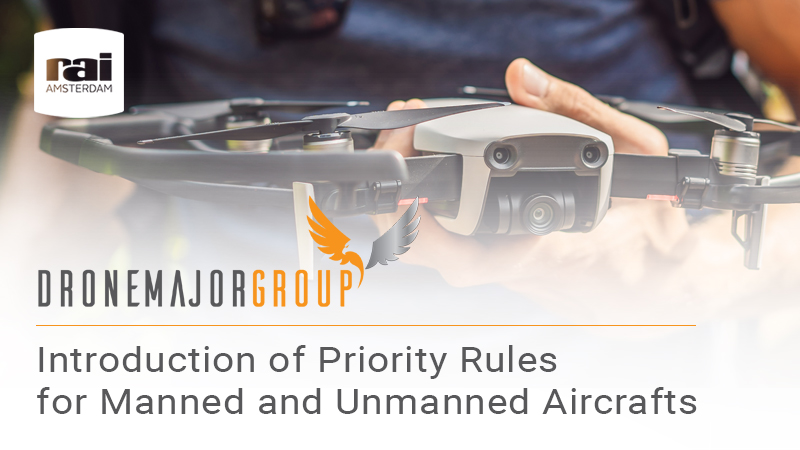Drone Major introduces significant client to Drone Evolution
Words By: Drone Major
Editorial Feature
Words By: Drone Major
Growing number of drones requires uniform European regulations
The rapidly increasing number of complex flights undertaken by drones makes the adoption of further European regulations on U-Space more critical than ever. In order to integrate all the various types of drones and drone-operations into the urban airspace, right-of-way rules will apply, with manned flights generally having right-of-way over unmanned flights.
The European Union Aviation Safety Agency (EASA) will present the main principles of the proposed draft regulation of the so-called “U-Space” at the beginning of December at Amsterdam Drone Week. The opinion will be proposed and clarified at the EASA High Level Conference on Drones, which will take place on the 5th and 6th of December.
It’s the first time anywhere in the world that such regulation on U-space/Unmanned Traffic Management (UTM) is being drafted and implemented according to EASA Executive director Patrick Ky. This regulation is prepared as a follow-up to the European drone regulations that were published last summer and that will come into force in June 2020. The latter regulations established requirements for smaller commercially oriented drones in particular. For example, requirements of a maximum flying height of 120 m, and a system was also made compulsory in order to prevent drones from entering no-fly zones.
Package deliveries
The number of drones in use, the range of applications, and the number of complex so-called “beyond the visual line of sight flights” are increasing very rapidly. This makes it even more critical to draft, adopt and implement a common set of rules for the European Member States, explains Ky. ‘We have to find a way to effectively regulate and manage air-traffic consisting of (smaller) drones in urban areas. Increasing numbers of players are making use of drones in our communal airspace. Google and Amazon aim to do so for delivering packages, and drones are also being used to inspect bridges, buildings, and power lines.’
A critical requirement is that drones must be able to communicate effectively with existing aircraft such as small aeroplanes and rescue helicopters that traditionally fly over urban areas at low altitudes. ‘The challenge is to integrate all the various types of drones and drone-operations into the urban airspace managed by U-space/UTM with the traditional urban traffic managed by air-traffic controllers as well as the new operators who will be participating in the urban airspace.'
U-space airspace and services
U-Space is intended to accomplish the above. It is actually a set of services that aim at managing drone traffic enabling drone operators to plan and execute their flights safely. The system maps out which type of drone is flying where. The objective is that every drone operator knows exactly where and when their drone is permitted to fly and where it is at all times.
Of course, collisions and accidents in urban areas must be prevented. That is also why all drones must be equipped with a sensor or other type of technical system or procedures for detecting other flying objects or obstacles. Aircraft pilots currently operate according to the principle of ‘see and avoid’, but drones are unmanned so this principle no longer applies. The principle then becomes ‘detect and avoid’. Right-of-way rules will also apply, with manned flights having right-of-way over unmanned flights and flights that fly beyond the visual line of sight having right-of-way over flights that fly within the visual line of sight. In collaboration with other authorities, industry and operational stakeholders EASA is working out the further details of this regulation.
Rapid pace
‘Doing nothing is not an option’, emphasises Ky. ‘In that case, every country would come up with its own regulations, with different rules applying in different countries.’ That would be far from ideal, as drones are also frequently used in cross-border areas to provide efficient services.
To develop this opinion on U-space, EASA has not been able to follow the standard regulations development process but has used an accelerated procedure. ‘By working this way, we were able to act as quickly as we have to. Otherwise, it would have taken much more time. In view of the extremely rapid pace of developments in the entire drone industry, we can simply not afford to lose any time.’ The proposed regulation must be completed by the end of the year beginning of 2020, after which the European Commission and the member states will discuss them. The goal is to have the new regulation adopted at the end of 2020.

Registration
Journalists are more than welcome to report on Amsterdam Drone Week. Accreditation for the event is possible via this link.
About Amsterdam Drone Week
The second edition of Amsterdam Drone Week from 4 to 6 December will make RAI Amsterdam the most important global venue for exchanging knowledge and expertise on current and future air mobility solutions, innovations, and essential regulations. It will be the meeting point where all top-level players, large and small, commercial and non-commercial, from various industries, knowledge institutes and authorised bodies will come together. The central theme will be, ‘How can drones be integrated effectively and efficiently into our airspace and how can urban areas best respond to these new developments?’ .
About EASA
The European Union Aviation Safety Agency (EASA) is the centerpiece of the European Union's strategy for aviation safety. Our mission is to promote and achieve the highest common standards of safety and environmental protection in civil aviation. EASA’s role in the domain of drones and urban air mobility is to prepare rules for all sizes of civil drones and harmonize standards for the commercial market across Europe to protect the safety and the privacy of EU citizens while enabling the free circulation of drones and a level playing field within the European Union.